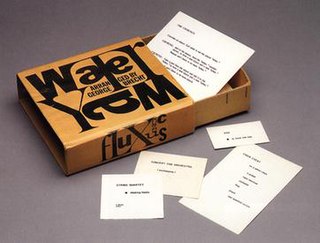
Fluxus was an international, interdisciplinary community of artists, composers, designers and poets during the 1960s and 1970s who engaged in experimental art performances which emphasized the artistic process over the finished product. Fluxus is known for experimental contributions to different artistic media and disciplines and for generating new art forms. These art forms include intermedia, a term coined by Fluxus artist Dick Higgins; conceptual art, first developed by Henry Flynt, an artist contentiously associated with Fluxus; and video art, first pioneered by Nam June Paik and Wolf Vostell. Dutch gallerist and art critic Harry Ruhé describes Fluxus as "the most radical and experimental art movement of the sixties".
A happening is a performance, event, or situation art, usually as performance art. The term was first used by Allan Kaprow during the 1950s to describe a range of art-related events.
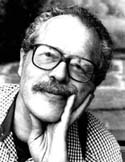
Dick Higgins was an American artist, composer, art theorist, poet, publisher, printmaker, and a co-founder of the Fluxus international artistic movement. Inspired by John Cage, Higgins was an early pioneer of electronic correspondence. Higgins coined the word intermedia to describe his artistic activities, defining it in a 1965 essay by the same name, published in the first number of the Something Else Newsletter. His most notable audio contributions include Danger Music scores and the Intermedia concept to describe the ineffable inter-disciplinary activities that became prevalent in the 1960s.

Alfred Earl "Al" Hansen was an American artist. He was a member of Fluxus, a movement that originated on an artists' collective around George Maciunas.
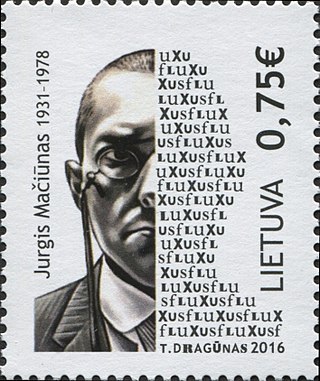
George Maciunas was a Lithuanian American artist, born in Kaunas. A founding member and the central coordinator of Fluxus, an international community of artists, architects, composers, and designers, he is most famous for organising and performing early happenings and for assembling a series of highly influential artists' multiples.
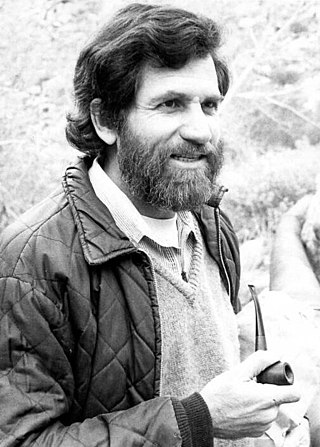
Allan Kaprow was an American painter, assemblagist and a pioneer in establishing the concepts of performance art. He helped to develop the "Environment" and "Happening" in the late 1950s and 1960s, as well as their theory. His Happenings — some 200 of them — evolved over the years. Eventually Kaprow shifted his practice into what he called "Activities", intimately scaled pieces for one or several players, devoted to the study of normal human activity in a way congruent to ordinary life. Fluxus, performance art, and installation art were, in turn, influenced by his work.

Alison Knowles is an American visual artist known for her installations, performances, soundworks, and publications. Knowles was a founding member of the Fluxus movement, an international network of artists who aspired to merge different artistic media and disciplines. Criteria that have come to distinguish her work as an artist are the arena of performance, the indeterminacy of her event scores resulting in the deauthorization of the work, and the element of tactile participation. She graduated from Pratt Institute in New York with an honors degree in fine art. In May 2015, she was awarded an honorary doctorate degree by Pratt.

George Brecht, born George Ellis MacDiarmid, was an American conceptual artist and avant-garde composer, as well as a professional chemist who worked as a consultant for companies including Pfizer, Johnson & Johnson, and Mobil Oil. He was a key member of, and influence on, Fluxus, the international group of avant-garde artists centred on George Maciunas, having been involved with the group from the first performances in Wiesbaden 1962 until Maciunas' death in 1978.
Something Else Press was founded by Dick Higgins in 1963. It published many important Intermedia texts and artworks by such Fluxus artists as Higgins, Ray Johnson, Alison Knowles, Allan Kaprow, George Brecht, Daniel Spoerri, Robert Filliou, Al Hansen, John Cage, Emmett Williams and by such important modernist figures as Gertrude Stein, Henry Cowell, and Bern Porter.
The mid-20th-century art movement Fluxus had a strong association with Rutgers University.
Geoffrey Hendricks was an American artist associated with Fluxus since the mid 1960s. He was professor emeritus of art at Rutgers University, where he taught from 1956 to 2003 and was associated with Allan Kaprow, Roy Lichtenstein, and Lucas Samaras during the 1960s.
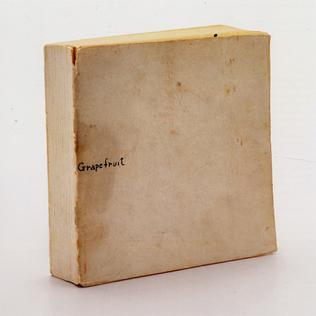
Grapefruit is an artist's book written by Yoko Ono, originally published in 1964. It has become famous as an early example of conceptual art, containing a series of "event scores" that replace the physical work of art – the traditional stock-in-trade of artists – with instructions that an individual may, or may not, wish to enact.
Grapefruit is one of the monuments of conceptual art of the early 1960s. She has a lyrical, poetic dimension that sets her apart from the other conceptual artists. Her approach to art was only made acceptable when [people] like Kosuth and Weiner came in and did virtually the same thing as Yoko, but made them respectable and collectible.
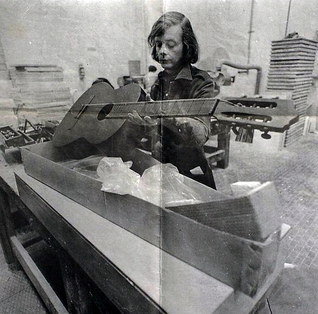
Joe Jones was an American avant-garde musician associated with Fluxus especially known for his creation of rhythmic music machines.

Spice Chess is an artist's multiple by the Japanese artist Takako Saito, while she was resident in the United States. Originally manufactured winter 1964–65, and offered for sale March 1965, the work is one of a famous series of disrupted chess sets referred to as Fluxchess or Flux Chess, made for George Maciunas' Fluxshop at his Canal Street loft, SoHo, New York City and later through his Fluxus Mail-Order Warehouse.
"Takako Saito engaged with Duchamp's practice but also with masculinist cold war metaphors by taking up chess as a subject of [her] art. Saito's fluxchess works... question the primacy of vision to chess, along with notions of perception and in aesthetic experience more generally.... Her "Smell Chess," "Sound Chess" and "Weight Chess" reworked the game of chess so that players would be forced to hone non-visual perception, such as the olfactory sense, tactility, and aurality, in order to follow chess rules." Claudia Mesch

Robert Marshall Watts (1923-1988) was an American artist best known for his work as a member of the international group of artists Fluxus. Born in Burlington, Iowa June 14, 1923, he became Professor of Art at Douglass College, Rutgers University, New Jersey in 1953, a post he kept until 1984. In the 1950s, he was in close contact with other teachers at Rutgers including Allan Kaprow, Geoffrey Hendricks and Roy Lichtenstein. This has led some critics to claim that pop art and conceptual art began at Rutgers.

Fluxus 1 is an artists' book edited and produced by the Lithuanian-American artist George Maciunas, containing works by a series of artists associated with Fluxus, the international collective of avant-garde artists primarily active in the 1960s and 1970s. Originally published in New York, 1964, the contents vary from edition to edition, but usually contain work by Ay-O, George Brecht, Alison Knowles, György Ligeti, Yoko Ono, Robert Watts and La Monte Young amongst many others.
Letty Lou Eisenhauer was an American visual and performance artist known for her free-spirited Fluxus performances during the 1960s. She is now on faculty at the Borough of Manhattan Community College as a counselor, professor, and forensic psychologist.
The Smolin Gallery was an avant-garde art venue and gallery on 57th Street in New York City, at its peak in the 1960s. It was known for its involvement with installation art, performance art and experimental art, and was best known for the Allan Kaprow assemblage performance of September 11–12, 1962 entitled "Words", believed to be the first allowing the audience to participate in an art gallery context. Kaprow "used two continual rolls of cloth with words from poems, newspapers, comic and telephone books" during which the audience were asked to "tear off the words, staple them together, write notes, even attack and hack them". Verbal fragments were pasted on the walls from floor to ceiling. In April 1963, Lima and Tony Towle gave their first public recital at the gallery.
Larry Miller is an American artist, most strongly linked to the Fluxus movement after 1969. He is "an intermedia artist whose work questions the borders between artistic, scientific and theological disciplines. He was in the vanguard of using DNA and genetic technologies as new art media." Electronic Arts Intermix, a pioneering international resource for video and new media art has said, "Miller has produced a diverse body of experimental art works as a key figure in the emergent installation and performance movements in New York in the 1970s... His installations and performances have integrated diverse mediums [sic] and materials."

The Museo Vostell Malpartida in the Spanish village Malpartida de Cáceres west of the provincial capital Cáceres in the Autonomous Community of Extremadura is dedicated to the work of the German painter, sculptor, Fluxus and Happening artist Wolf Vostell. The museum is under the artistic direction of Mercedes Vostell and under the general direction of José Antonio Agúndez García. The Museo Vostell Malpartida was founded by Wolf Vostell and Mercedes Vostell in 1976.
